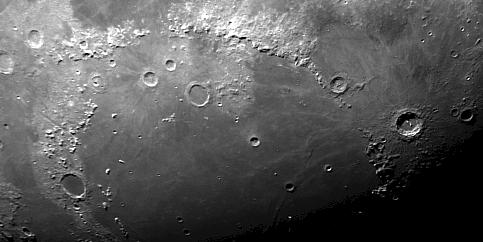Observing the Moon: Mare Imbrium
Jack Kramer
When I began observing (as a teenager, a long, long time ago), the first object I observed was the Moon. That may still be what most new observers do. And the first object I recall noting on the Moon was the Mare Imbrium region. That's because it's visible in the evening beginning just after first quarter phase and it contains a lot of varied detail -- everything from a large, flat maria to craters of different shapes and ages. Today you too may still linger over this area.
The CCD image below was downloaded from a computer bulletin board and shows just the Imbrium region. It's oriented with lunar north to the left. So you'll have to rotate the picture a half turn to see how it'll look as the typical telescopic inverted image. The features noted here are easily visible in even the smallest amateur telescopes.

When the Moon is about eight days old (barely past first quarter), the crater Plato pops into view at the terminator. It has a flat, lava-filled interior and a rim that doesn't appear very high. However, with the Sun at a very oblique angle at this time, I once caught the Moon when the rim cast its shadow about half way across the crater floor. The shadow was very jagged with the higher points of the wall showing as "spikes" of darkness. Variations in the height of the rim were obviously exaggerated, but it dramatically showed that the rim is somewhat more rugged than it seems from our Earthly perspective.
Another feature that stands out well is the Alpine Valley that slices through the mountain range surrounding the Imbrium basin. At first quarter, the valley floor is in shadow, so it appears as a prominent, perfectly straight slash. As the Sun rises higher in the lunar sky, the valley becomes less prominent, but it can be seen under high magnification at almost any phase when it's lit.
The area provides good comparisons between old and new craters. Plato and Archimedes are obviously senior citizens; their floors have been filled in as the result of lava eruptions. The large, rugged crater Copernicus is newer, as evidenced by its higher, more rugged walls and the central peaks.
Take a look also at Cassini. We might name it the "Bullseye Crater": a crater-within-a-crater. You'll often see craters with newer ones superimposed on the floor or walls, but usually they're not quite so prominent as this one. There's also an additional, smaller crater up against the inner wall of Cassini.
Published in the January 1996 issue of the NightTimes




